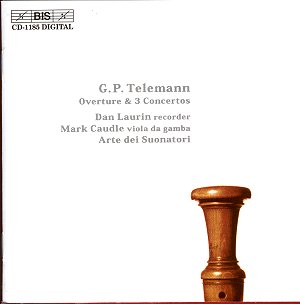The very first book on J.S.Bach I ever read concocted
an absurd Mozart/Salieri type rivalry between Bach and Telemann, whose
music was denounced as superficially popular and worthless. "Fortunately,"
the author gloated, "all his music has been lost!" Far from
being rivals, Bach and Telemann were great friends and mutual admirers.
Telemann was the godfather of C.P.E. Bach, a responsibility he fulfilled
with enthusiasm; and, on the death of Bach, Telemann wrote a greatly
touching elegiac poem. Only in rare instances is it possible to determine
even approximate composition dates for Telemann’s music.
Nowadays Telemann is reckoned as one of the great ones
and his music, far from being lost, overwhelms us with its quantity—several
hundred overtures are included in the Darmstadt manuscript "TWV
55"—and has become so popular that I wallow in the luxury of being
able to compare this recording of the Suite in a to three others
of the same work in my collection, as follows:
|
Soloist
|
Ensemble
|
CD number
|
timing
|
|
Dan Laurin
|
Arte dei Suonatori
|
BIS CD 1185
|
30.58
|
|
Micaela Petri
|
Brown, ASMF
|
Phillips 410 041-2
|
25.49
|
|
Frans Brüggen
|
Tilegant, SWD Kammerorkester
|
Teldec 9031-77620-2
|
26.46*
|
|
Michael Schneider
|
Schneider, Camerata Köln
|
DHM 05472 77324 2
|
31.40
|
*ADD
So it is a contest between English, Swedish, German,
and Dutch recorder virtuosi. The Laurin recording is close and full
and the Suonatori play with grace as well as punch (Track 1). Petri
plays sweetly and crisply, and the ASMF alternates Purcellian pathos
with Purcellian glee. Schneider emphasises the Germanic sense of drama
and wit in the work and achieves a very natural sound quality (his is
probably the most satisfying version overall). Tilegant and Brown each
omit a four minute repeat in the first movement and conduct real chamber
orchestras—the other two groups are small ensembles. Tilegant’s 1962
analogue sound is beginning to show its age. But in terms of overall
playing quality the soloists are all so good that one can hardly now
remember the time when the recorder was thought of as an unpleasant
or inexpressive instrument, a time when we put up with, breathy, off
pitch, squeaky, shrieky playing and praised it as "authentic."
The various string groups support the soloist in each case with perfect
empathy, no ordinary accomplishment with the intricate rhythms and shifts
of colour, and with the soloists following their own hearts in improvising
the ornaments. All of the groups perform with a classic sound, taking
reasonable but not distracting account of informed original performance
practice.
With regard to the other concertos on this disk, we
do not have comparisons and one can only say that they are played beautifully
and with great enthusiasm. None is a masterpiece of the level of the
Suite, but all are engaging. Mr. Laurin teaches recorder at the Stockholm
Royal University College of Music, and embellishes the slow movements
of the concertos with extravagant roulades and flourishes demonstrating
his exceptional ability and engaging musicianship (Track 10). Mr. Caudle
is a guest soloist from England and his amiable partnership with Mr.
Laurin in the double concerto results in a fascinating play of colours
(Track 15). The Handelian sound of the Concerto in C reminds us that
Handel and Telemann were also good friends and corespondents and occasionally
exchanged music.
Paul Shoemaker
